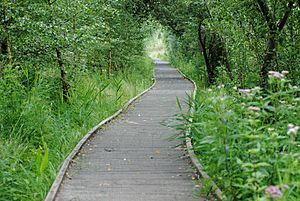Lattersey Field facts for kids
Quick facts for kids Lattersey Field |
|
|---|---|

A raised walkway at Lattersey Field
|
|
| Type | Local Nature Reserve |
| Location | Whittlesey, Cambridgeshire |
| OS grid | TL 282 966 |
| Area | 11.9 hectares |
| Managed by | Wildlife Trust for Bedfordshire, Cambridgeshire and Northamptonshire |
Lattersey Field is a special place in Whittlesey, Cambridgeshire, covering about 11.9 hectares (that's like 29 football fields!). It's known as a Local Nature Reserve, which means it's protected for its important wildlife and natural features. Fenland District Council owns this amazing area, and it's looked after by the Wildlife Trust for Bedfordshire, Cambridgeshire and Northamptonshire. They work hard to keep it a safe home for many plants and animals.
Contents
What Makes Lattersey Field Special?
Lattersey Field wasn't always a nature reserve. It used to be a place where people dug up clay to make bricks. Because of this, there are now big holes that have filled with water, creating cool ponds and marshy areas. This mix of old quarry pits, water, and different types of land makes Lattersey Field a really diverse habitat.
A Mix of Habitats
At Lattersey Field, you can find many different environments all in one place.
- Grassland: Open grassy areas where small animals can hide and birds can forage.
- Woodland: Areas with trees, providing shelter and food for many creatures.
- Scrub: Bushy areas with dense plants, perfect for nesting birds.
- Pools: Pits filled with water, home to fish, insects, and amphibians.
- Marshes: Wet, grassy areas that are often flooded, great for wading birds.
- Reedbeds: Areas filled with tall reeds, which are important for certain bird species.
This variety of habitats means that many different kinds of plants and animals can live here.
Amazing Animals You Might See
Lattersey Field is a busy place for wildlife! If you visit quietly and keep your eyes open, you might spot some fascinating creatures.
Mammals
- Water Voles: These furry, semi-aquatic rodents love to live near water. They are excellent swimmers and dig burrows along the banks of the pools and marshes.
- Water Shrews: Even smaller than water voles, these tiny mammals are also great swimmers and hunt for insects in the water.
Birds
Lattersey Field is a fantastic spot for birdwatching, especially because of its diverse habitats.
- Sedge Warblers: These small, active birds are often heard singing loudly from the reedbeds during spring and summer.
- Tawny Owls: You might hear their distinctive "hoo-hoo-hoo-hooo" call at dusk or dawn, as these nocturnal hunters search for food in the woodland areas.
- Woodcocks: These shy birds are masters of camouflage and are often found in the wetter, wooded parts of the reserve.
- Great Spotted Woodpeckers: Look for these striking black, white, and red birds pecking at tree trunks, searching for insects.
- Reed Buntings: These small birds with distinctive head patterns are often seen perched on reeds in the marshy areas.
Visiting Lattersey Field
Lattersey Field is a great place to explore nature. You can easily get to the reserve from New Road, which actually goes right through the middle of the site. This makes it easy for visitors to access and enjoy the different parts of this wonderful nature reserve. Remember to stay on the paths and respect the wildlife when you visit!

